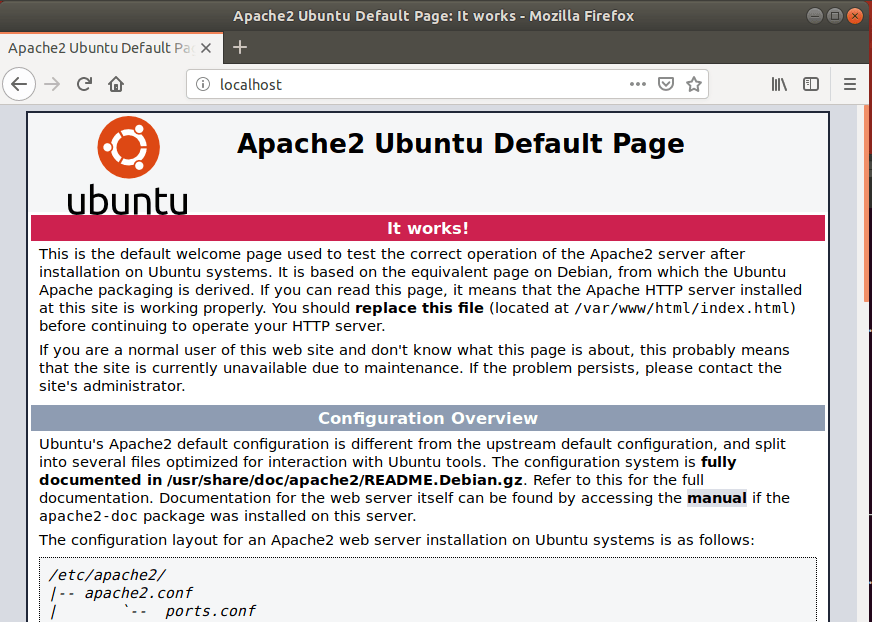If you are looking for a solution to build dynamic and beautiful websites, then SPIP CMS is a good place to start. It is built on an open-source core with support for open standards, which might be very useful in helping you run your digital content. This CMS platform is designed for ease of use to allow webmasters to collaborate and automate engaging experiences with users across multiple devices, including mobile. For more about SPIP CMS, please check their Homepage This brief tutorial is going to show students and new users how to install SPIP CMS on Ubuntu 16.04 / 18.10 and 18.04 LTS. To get started with installing SPIP CMS, follow the steps below:
Install Apache2 HTTP Server
SPIP CMS requires a web server and the Apache2 HTTP server is the most popular open-source web server available today. To install the Apache2 server, run the commands below: After installing Apache2, the commands below can be used to stop, start and enable the Apache2 service to always start up with the server boots. Now that Apache2 is installed. to test whether the web server is working, open your browser and browse to the URL below. If you see the page above, then Apache2 is successfully installed.
Install MariaDB Database Server
SPIP CMS also requires a database server to store its content. If you’re looking for a truly open-source database server, then MariaDB is a great place to start. To install MariaDB run the commands below: After installing MariaDB, the commands below can be used to stop, start and enable the MariaDB service to always start up when the server boots. Run these on Ubuntu 16.04 LTS Run these on Ubuntu 18.10 and 18.04 LTS Next, run the commands below to secure the database server with a root password if you were not prompted to do so during the installation. When prompted, answer the questions below by following the guide.
Enter current password for root (enter for none): Just press the Enter Set root password? [Y/n]: Y New password: Enter password Re-enter new password: Repeat password Remove anonymous users? [Y/n]: Y Disallow root login remotely? [Y/n]: Y Remove test database and access to it? [Y/n]: Y Reload privilege tables now? [Y/n]: Y
Now that MariaDB is installed, to test whether the database server was successfully installed, run the commands below. type the root password when prompted. If you see a similar screen as shown above, then the server was successfully installed.
Install PHP 7.2 and Related Modules
SPIP CMS is a PHP-based CMS and PHP is required. However, PHP 7.2 may not be available in Ubuntu’s default repositories. To run PHP 7.2 on Ubuntu 16.04 and previous, you may need to run the commands below: Then update and upgrade to PHP 7.2 Next, run the commands below to install PHP 7.2 and related modules. After installing PHP 7.2, run the commands below to open the PHP default configuration file for Apache2. The lines below are a good setting for most PHP-based CMS. Update the configuration file with these and save. Every time you make changes to the PHP configuration file, you should also restart the Apache2 web server. To do so, run the commands below: Now that PHP is installed, to test whether it’s functioning, create a test file called phpinfo.php in the Apache2 default root directory. ( /var/www/html/) Then type the content below and save the file. Next, open your browser and browse to the server’s hostname or IP address followed by phpinfo.php You should see the PHP default test page.
Create SPIP CMS Database
Now that you’ve installed all the packages that are required for SPIP CMS to function, continue below to start configuring the servers. First, run the commands below to create a blank SPIP CMS database. To log on to the MariaDB database server, run the commands below. Then create a database called spip Create a database user called spipuser with a new password Then grant the user full access to the database. Finally, save your changes and exit.
Download SPIP CMS Latest Release
To get SPIP CMS’s latest release you may want to its auto installer script. Run the commands below to download the script and run it to install SPIP CMS. Then run the commands below to set the correct permissions for the SPIP CMS root directory and give Apache2 control.
Configure Apache2
Finally, configure the Apahce2 site configuration file for wityCMS. This file will control how users access SPIP CMS content. Run the commands below to create a new configuration file called spipcms.conf Then copy and paste the content below into the file and save it. Replace the highlighted line with your domain name and directory root location. Save the file and exit.
Enable the wityCMS and Rewrite Module
After configuring the VirtualHost above, enable it by running the commands below Then open your browser and browse to the server domain name. You should see the SPIP CMS setup wizard complete. Please follow the wizard carefully. Then follow the on-screen instruction. Choose the installation language and click Next to continue On the database connection page, type in the database user name and password you created above and continue. Choose the database created above and continue After that, create an admin account and continue That should install your site. Enjoy~ Congratulation! You have successfully installed SPIP CMS on Ubuntu 16.04 | 18.04 and 18.10. You may also like the post below:



